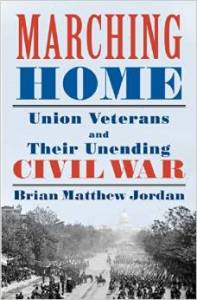 Marching Home – Union Veterans and Their Unending Civil War, by Brian Matthew Jordan, photos, notes, index, 374 pp., 2015, Liveright Publishing Corporation, $28.95
Marching Home – Union Veterans and Their Unending Civil War, by Brian Matthew Jordan, photos, notes, index, 374 pp., 2015, Liveright Publishing Corporation, $28.95
Reviewed by Robert C. Plumb
We know the story. The end of the Civil War. Men in gray returned home, vanquished, dispirited, but confident that they fought bravely and with a transcending spirit of honor in their hearts. Men in blue returned victorious, many bearing the wounds of war – the missing limb, the disfigured face – but they lived with the certainty that they had prevailed. As tottering, white-bearded old men they would march in celebratory parades, even mingle with their old foes on past fields of battle, such as Gettysburg. These men in blue were, after all, the victors.
Yet among the nostalgic memories of Union Civil War veterans that history has presented to us lay a more disturbing and accurate account of their post-war lives. Historian Brian Matthew Jordan’s Marching Home describes a troubling narrative of Union veterans as they struggled to transition from soldiers to citizens. Jordan writes: “Demobilization at first glance was a stunning success for 800,000 men, but it was in fact a protracted process, punctuated with delay, discomfort and even disaster.” And that was just the start of the returning veterans’ problems adjusting to “normal” lives after the “fiery trial” of the American Civil War.
Far from universally receiving a hero’s welcome, Union soldiers often were feared and resented by the civilian population. Eager to put the war and its unpleasantness behind them, civilians questioned: Are these men suited to do anything beyond killing? The war is over, can’t we just put it behind us and move on to life as it was before? Among the unscrupulous civilians, veterans were the targets of robbery and swindles. “Magic tonics” to cure a variety of maladies were sold to naïve young veterans in hopes of relieving “chronic diarrhea, dysentery, and render invisible any vestiges of the war.”
Actions by some returning veterans only reinforced the enmity of civilians. In Davenport. Iowa, Jordan reports, “Discharged soldiers ‘maddened by liquor’ mutinied in the streets. They smashed windows, ransacked houses, and ‘destroyed everything generally.’ Local citizens were so rattled by veteran misdeeds that they collected on the docks as the next regiment to arrive … chugged into the city. ‘Don’t let a man get off’ they beseeched.” One enlisted man remarked: “Even the Negro children in the South had many times been more glad to see us than our own fellow citizens here.”
Some Northern officers, most notably Quartermaster General Montgomery C. Meigs, took measures to help “the brave heroes of our Army [who] are being sent home by the thousands every day.” Meigs attempted to ensure that soldiers upon discharge were transported home as quickly and comfortably as possible. The Quartermaster General was a rare advocate for the former Union soldiers seeking to transition to civilian life.
Attempts were made to place severely wounded Union veterans in “soldiers’ homes” to help care for the returning wounded warriors. Physically and often mentally wounded, residents of these institutions often reflected the opinion of one such soldier. “There is nothing within that is not dead already. The ‘Soldiers’ Home Pariah’ lives in an accursed place.” As anti-slavery speaker and activist Anna Dickenson reported, “Only on the grounds of a Soldiers’ Home, teeming with one-armed and one-legged soldiers, could one encounter the whole panorama of the war.”
Author Jordan cites example after example in this exhaustively researched book. This is not a work of speculation, but a well-documented, carefully annotated narrative. He has the academic credibility appropriate for the task (Gettysburg College, Ph.D. from Yale), yet his writing is thankfully free from the tangled jargon often marring the texts of today’s university-based historians. At many points in the book, his writing style reminds the reader of the clarity and emotive power of Bruce Catton’s prose.
The scope of this book goes beyond the realm of the physical wounds suffered by returning veterans. Jordan also documents the mental condition that many soldiers harbored after their Union service. Based on examples gleaned from letters, diaries, and detailed third-person accounts, Jordan describes the post-traumatic stress among soldiers during the period following the Civil War. Clearly this was a problem not unique to late 20th and early 21st century soldiers.
Time has a way of polishing smooth the rough edges of historical experience. Jordan brings us back to the cold, hard reality of those who fought and survived the Civil War with personal vignettes that are as revealing as they are heart-breaking. Long after the final Grand Army of the Republic exuberant parade has ended and the last note of the jubilant trumpet has sounded in Union veteran halls, there is the sobering reality reflected in the haunting poem of William Oland Bourne published in the Civil War Union soldier’s newspaper Soldier’s Friend:
Suffering and sad
Knowing not where to go,
Wandering the city through
Having no work to do
Wishing he had!
Wishing all day in vain
With hearts filled with pain,
And a hard bitter strain,
Driving him mad!
What shall he do for bread?
Where shall he lay his head?
Suffering and sad.
William Oland Bourne
Soldier’s Friend, October, 1865
